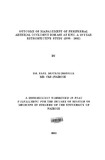| dc.contributor.author | Mbugua, Paul M | |
| dc.date.accessioned | 2013-05-23T11:33:31Z | |
| dc.date.available | 2013-05-23T11:33:31Z | |
| dc.date.issued | 2002 | |
| dc.identifier.citation | Master of Medicine in Surgery, University of Nairobi, 2002 | en |
| dc.identifier.uri | http://erepository.uonbi.ac.ke:8080/xmlui/handle/11295/24830 | |
| dc.description.abstract | This is a retrospective study of the outcome of management of PAOD at KNH. It covered a 10 year
period between January 1993 and November 2002. It was carried out by a review of medical records.
A total of 80 patients with 100 involved limbs were studied. Twenty four patients were excluded from
the study as their files could not be traced or lacked sufficient data for analysis. Ninety three lower
limbs and seven upper limbs were involved. Twenty five patients had bilateral lower limb disease and
one had bilateral upper limb disease.
There were 61 (76.3%) males and 19 (23.8%) females giving a male: female ration of 3.2: 1.
The mean age of the patients seen was 52.6 years with a range of 16 to 100 years. The disease was
uniformly spread between the ages of 30 to 79 years in both males and females.
The majority of patients (72.6%) had primary level of education and below. Central province had the
highest number of patients by birth (56.3 %).
Fifty percent of the patients were smokers while 15% were diabetics and 15% hypertensives.
Gangrene and rest pain were the most frequent presenting features occurring in 63% and 59% of the
cases respectively.
Arteriography as a diagnostic modality was used in 80.6% of the cases.
Amputation was the most common primary mode of management reflecting the late presentation of the
disease at presentation. It was done in 26 (32.5%) cases as the sole procedure and in 6 (7.5%) cases in
combination with other primary procedures. Conservative management formed the next common mode
of management in 16 (20.0%) cases. Amputation also formed the commonest secondary mode of
management following failure of a primary revascularization procedure or after failure of conservative
management.
There was a statistically significant higher rate of secondary procedures after graft surgery than after
amputation.
The rate of sepsis following primary amputation (46.2%) was statistically higher than following graft
surgery (8.3) | en |
| dc.language.iso | en | en |
| dc.publisher | University of Nairobi. | en |
| dc.title | Outcome of management of peripheral arterial occlusive disease at KNH. a 10 year retrospective study (1993 - 2002) | en |
| dc.type | Thesis | en |
| dc.description.department | a
Department of Psychiatry, University of Nairobi, ; bDepartment of Mental Health, School of Medicine,
Moi University, Eldoret, Kenya | |
| local.publisher | Faculty of Medicine | en |

